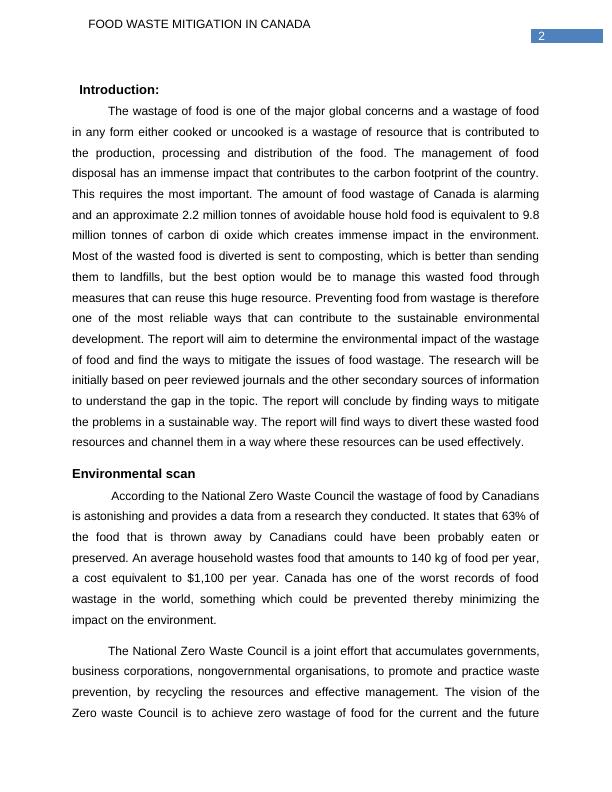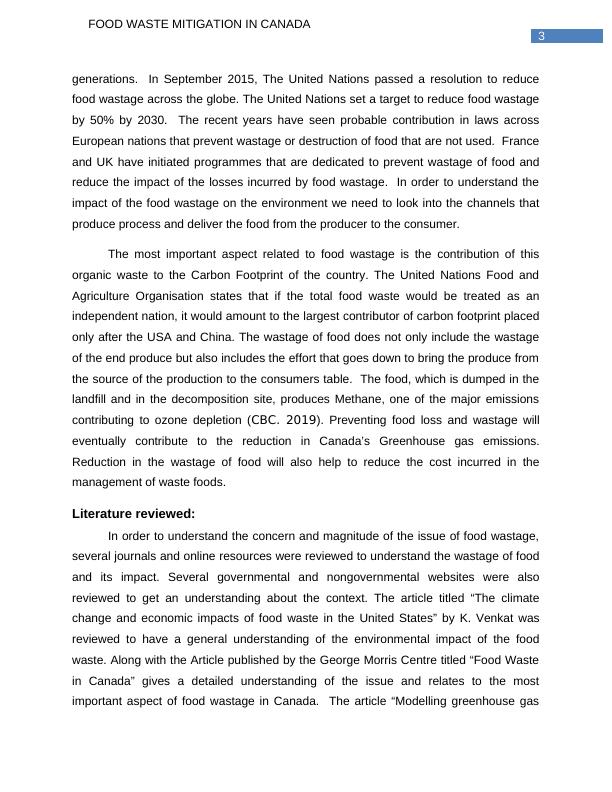Food Waste Mitigation in Canada
Added on 2023-04-24
10 Pages2992 Words373 Views
Running head: FOOD WASTE MITIGATION IN CANADA
FOOD WASTE MITIGATION IN CANADA
Name of the Student
Name of the University
Author Note
FOOD WASTE MITIGATION IN CANADA
Name of the Student
Name of the University
Author Note

2
FOOD WASTE MITIGATION IN CANADA
Introduction:
The wastage of food is one of the major global concerns and a wastage of food
in any form either cooked or uncooked is a wastage of resource that is contributed to
the production, processing and distribution of the food. The management of food
disposal has an immense impact that contributes to the carbon footprint of the country.
This requires the most important. The amount of food wastage of Canada is alarming
and an approximate 2.2 million tonnes of avoidable house hold food is equivalent to 9.8
million tonnes of carbon di oxide which creates immense impact in the environment.
Most of the wasted food is diverted is sent to composting, which is better than sending
them to landfills, but the best option would be to manage this wasted food through
measures that can reuse this huge resource. Preventing food from wastage is therefore
one of the most reliable ways that can contribute to the sustainable environmental
development. The report will aim to determine the environmental impact of the wastage
of food and find the ways to mitigate the issues of food wastage. The research will be
initially based on peer reviewed journals and the other secondary sources of information
to understand the gap in the topic. The report will conclude by finding ways to mitigate
the problems in a sustainable way. The report will find ways to divert these wasted food
resources and channel them in a way where these resources can be used effectively.
Environmental scan
According to the National Zero Waste Council the wastage of food by Canadians
is astonishing and provides a data from a research they conducted. It states that 63% of
the food that is thrown away by Canadians could have been probably eaten or
preserved. An average household wastes food that amounts to 140 kg of food per year,
a cost equivalent to $1,100 per year. Canada has one of the worst records of food
wastage in the world, something which could be prevented thereby minimizing the
impact on the environment.
The National Zero Waste Council is a joint effort that accumulates governments,
business corporations, nongovernmental organisations, to promote and practice waste
prevention, by recycling the resources and effective management. The vision of the
Zero waste Council is to achieve zero wastage of food for the current and the future
FOOD WASTE MITIGATION IN CANADA
Introduction:
The wastage of food is one of the major global concerns and a wastage of food
in any form either cooked or uncooked is a wastage of resource that is contributed to
the production, processing and distribution of the food. The management of food
disposal has an immense impact that contributes to the carbon footprint of the country.
This requires the most important. The amount of food wastage of Canada is alarming
and an approximate 2.2 million tonnes of avoidable house hold food is equivalent to 9.8
million tonnes of carbon di oxide which creates immense impact in the environment.
Most of the wasted food is diverted is sent to composting, which is better than sending
them to landfills, but the best option would be to manage this wasted food through
measures that can reuse this huge resource. Preventing food from wastage is therefore
one of the most reliable ways that can contribute to the sustainable environmental
development. The report will aim to determine the environmental impact of the wastage
of food and find the ways to mitigate the issues of food wastage. The research will be
initially based on peer reviewed journals and the other secondary sources of information
to understand the gap in the topic. The report will conclude by finding ways to mitigate
the problems in a sustainable way. The report will find ways to divert these wasted food
resources and channel them in a way where these resources can be used effectively.
Environmental scan
According to the National Zero Waste Council the wastage of food by Canadians
is astonishing and provides a data from a research they conducted. It states that 63% of
the food that is thrown away by Canadians could have been probably eaten or
preserved. An average household wastes food that amounts to 140 kg of food per year,
a cost equivalent to $1,100 per year. Canada has one of the worst records of food
wastage in the world, something which could be prevented thereby minimizing the
impact on the environment.
The National Zero Waste Council is a joint effort that accumulates governments,
business corporations, nongovernmental organisations, to promote and practice waste
prevention, by recycling the resources and effective management. The vision of the
Zero waste Council is to achieve zero wastage of food for the current and the future

3
FOOD WASTE MITIGATION IN CANADA
generations. In September 2015, The United Nations passed a resolution to reduce
food wastage across the globe. The United Nations set a target to reduce food wastage
by 50% by 2030. The recent years have seen probable contribution in laws across
European nations that prevent wastage or destruction of food that are not used. France
and UK have initiated programmes that are dedicated to prevent wastage of food and
reduce the impact of the losses incurred by food wastage. In order to understand the
impact of the food wastage on the environment we need to look into the channels that
produce process and deliver the food from the producer to the consumer.
The most important aspect related to food wastage is the contribution of this
organic waste to the Carbon Footprint of the country. The United Nations Food and
Agriculture Organisation states that if the total food waste would be treated as an
independent nation, it would amount to the largest contributor of carbon footprint placed
only after the USA and China. The wastage of food does not only include the wastage
of the end produce but also includes the effort that goes down to bring the produce from
the source of the production to the consumers table. The food, which is dumped in the
landfill and in the decomposition site, produces Methane, one of the major emissions
contributing to ozone depletion (CBC. 2019). Preventing food loss and wastage will
eventually contribute to the reduction in Canada’s Greenhouse gas emissions.
Reduction in the wastage of food will also help to reduce the cost incurred in the
management of waste foods.
Literature reviewed:
In order to understand the concern and magnitude of the issue of food wastage,
several journals and online resources were reviewed to understand the wastage of food
and its impact. Several governmental and nongovernmental websites were also
reviewed to get an understanding about the context. The article titled “The climate
change and economic impacts of food waste in the United States” by K. Venkat was
reviewed to have a general understanding of the environmental impact of the food
waste. Along with the Article published by the George Morris Centre titled “Food Waste
in Canada” gives a detailed understanding of the issue and relates to the most
important aspect of food wastage in Canada. The article “Modelling greenhouse gas
FOOD WASTE MITIGATION IN CANADA
generations. In September 2015, The United Nations passed a resolution to reduce
food wastage across the globe. The United Nations set a target to reduce food wastage
by 50% by 2030. The recent years have seen probable contribution in laws across
European nations that prevent wastage or destruction of food that are not used. France
and UK have initiated programmes that are dedicated to prevent wastage of food and
reduce the impact of the losses incurred by food wastage. In order to understand the
impact of the food wastage on the environment we need to look into the channels that
produce process and deliver the food from the producer to the consumer.
The most important aspect related to food wastage is the contribution of this
organic waste to the Carbon Footprint of the country. The United Nations Food and
Agriculture Organisation states that if the total food waste would be treated as an
independent nation, it would amount to the largest contributor of carbon footprint placed
only after the USA and China. The wastage of food does not only include the wastage
of the end produce but also includes the effort that goes down to bring the produce from
the source of the production to the consumers table. The food, which is dumped in the
landfill and in the decomposition site, produces Methane, one of the major emissions
contributing to ozone depletion (CBC. 2019). Preventing food loss and wastage will
eventually contribute to the reduction in Canada’s Greenhouse gas emissions.
Reduction in the wastage of food will also help to reduce the cost incurred in the
management of waste foods.
Literature reviewed:
In order to understand the concern and magnitude of the issue of food wastage,
several journals and online resources were reviewed to understand the wastage of food
and its impact. Several governmental and nongovernmental websites were also
reviewed to get an understanding about the context. The article titled “The climate
change and economic impacts of food waste in the United States” by K. Venkat was
reviewed to have a general understanding of the environmental impact of the food
waste. Along with the Article published by the George Morris Centre titled “Food Waste
in Canada” gives a detailed understanding of the issue and relates to the most
important aspect of food wastage in Canada. The article “Modelling greenhouse gas

End of preview
Want to access all the pages? Upload your documents or become a member.
Related Documents
Project Management for Inclusive Design: Addressing Food Wastage and Environmental Impactlg...
|18
|3974
|166
Food Bank and Its Functions: The Impact of Food Waste Destroys the Envionlg...
|18
|3280
|44
Sustainable Development: Food Production and Wastage in Healthcare Industrylg...
|10
|722
|105
Food Wastage in Australian Health Industrylg...
|5
|688
|343
Food Wastage Control Systemlg...
|7
|1852
|113
Social Media Marketing Strategy Assignmentlg...
|11
|2773
|33
